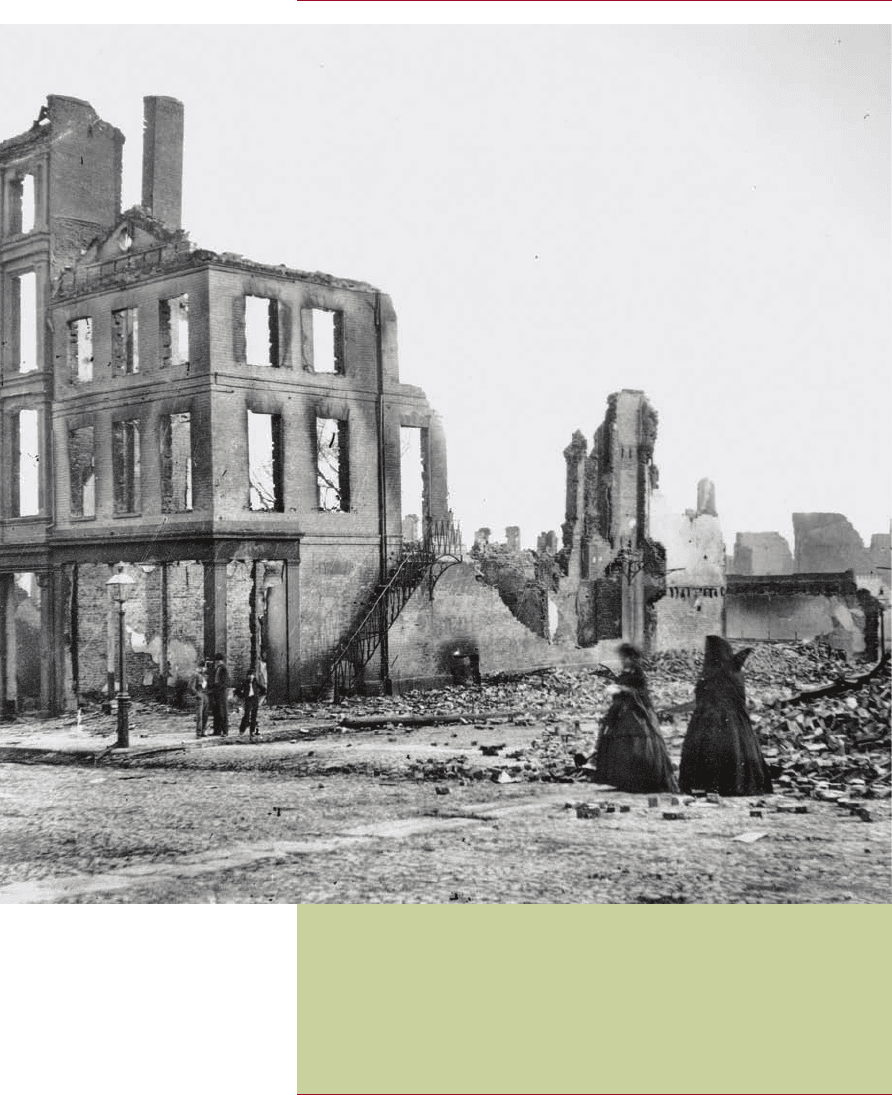McNeese T. The Civil War Era 1851-1865 (Discovering U.S. History)
Подождите немного. Документ загружается.


The Civil War Era
120
Southerners review the ruins of Richmond. After a
long siege, Union forces captured the town in
April 1865. Retreating Confederate forces were
ordered to burn bridges and other key buildings.
The fi res went unchecked, causing serious damage.
BOOK_5_CIVIL.indd 120 11/8/09 10:49:23

121
only admitted one mistake as a commander—ordering the
charge at Cold Harbor. But the victory there would be the
last for Robert E. Lee. Nine days later Grant’s forces met up
with General Benjamin Butler’s Army of the James.
On June 15 the Federals launched an assault toward the
Virginia community of Petersburg, south of Richmond by
30 miles (48 km). Petersburg was an important rail junction
that had helped protect the Confederate capital throughout
the war. If the town could be captured by Grant, Richmond
would be extremely vulnerable. But the assault was bungled,
perhaps due to “Cold Harbor Syndrome,” where earlier loss-
es had been devastating. Rather than Petersburg falling eas-
ily to the Yankees, Grant was forced to order a siege. General
Lee had no choice but to remain in Petersburg and its vicin-
ity, since moving out of the region would leave Richmond
vulnerable to attack. Through six weeks of almost constant
fighting Grant had managed to checkmate Lee into inaction,
through his tenacity and sheer numbers of men.
SHERMAN’S MARCH
Even as Grant and Lee had taken up the fight in early May,
General Sherman had set out from Chattanooga, bound for
Atlanta. He moved similarly to Grant, by his left flank, skirt-
ing repeatedly around a Confederate force led by General
Joseph Johnston, who had commanded troops in Virginia
before Robert E. Lee. At times Johnston himself fell back to
avoid a fight against Sherman’s superior numbers. There were
engagements, as well, as at New Hope Church, 25 miles (40
km) northeast of Atlanta, where Johnston held Sherman back
for two weeks. Then, on June 27, Sherman ordered a direct
frontal assault toward Johnston’s army entrenched on Ken-
nesaw Mountain, where the Union commander misjudged
Johnston to be overextended. Perhaps he thought he might
accomplish an assault as successful as Missionary Ridge, but
Grant and Lee’s War
BOOK_5_CIVIL.indd 121 11/8/09 10:49:23

The Civil War Era
122
he was wrong. The Federals were routed. Sherman shrugged
the fight off and moved forward, around Johnston’s army,
ever toward Atlanta.
On July 17 a frustrated President Davis replaced John-
ston, convinced that his general was not fighting hard
enough, with 33-year-old Texan Lieutenant General John
Bell Hood. Hood had fought throughout the war, and had
a reputation for tenacity. He had lost the use of his left arm
during the Gettysburg battle and had his right leg amputated
after Chickamauga. Hood would fight even when dramati-
cally outnumbered, but such fights only caused Hood’s army
to dwindle in number as Sherman came closer to Atlanta.
Prior to the war Atlanta had been home to 12,000 citizens,
but many had evacuated the city with Sherman’s men head-
ed their way. By September 2, Union forces had captured
the Georgia city, and Sherman sent a telegram to the War
Department in Washington, notes historian Geoffrey Ward:
“Atlanta is ours, and fairly won.”
Sherman’s success at Atlanta could not have been better
timed for Abraham Lincoln. The President was running for
reelection, even in the midst of civil war. Although the direc-
tion of the three-and-a-half year conflict was turning in favor
of the North, there were still Northern critics who advocated
ending the conflict immediately and allowing the South to
remain separate from the Union. Complicating matters even
more was Lincoln’s opponent. The Democratic nominee was
none other than George McClellan.
As Sherman launched his campaign he cut off his own
supply line, intending for his men to live off the land. March-
ing across Georgia, Sherman’s army stretched 60 miles (100
km) wide. His men stripped the region of everything that
might be used to support the Confederate war effort, such as
railroad lines, telegraph poles, factories, and other means of
production, along with food and livestock taken from farms
BOOK_5_CIVIL.indd 122 11/8/09 10:49:23

123
and plantations to feed them. For weeks Sherman’s “March
to the Sea” left a trail of devastation, fulfilling the Union
commander’s intention, notes historian Geoffrey Ward, to
“make Georgia howl.”
Welcome Support
In the meantime, Lincoln had won reelection. Despite his
fears that he would not be reelected, the president managed
to defeat McClellan with a wide majority of electoral votes—
212 to 21. The former Union commander only carried three
states—Delaware, Kentucky, and New Jersey. While Lin-
coln had won with only 41 percent of the popular vote in
1860, he pulled 55 percent in 1864. Perhaps most telling
was the soldier vote. Ballots had been prepared for Federal
soldiers, who had to choose between their commander-in-
chief and their former military commander. Overwhelm-
ingly, the soldiers supported Lincoln, who won 78 percent
of their ballots. Even among the troops of the Army of the
Potomac, McClellan’s old command, only 29 percent voted
for McClellan. The election made it clear to Lincoln that
Northerners supported a successful conclusion to the war
and had rejected any suggestion that the South be allowed
to go its own way.
By December 21 Sherman’s men were outside Savannah.
After the local Rebel army of 15,000 abandoned the city, Sher-
man sent Lincoln a telegram bearing welcome news, notes
James McPherson: “I beg to present you as a Christmas gift
the city of Savannah.” The Union Army then turned north
into the Carolinas, where they occupied Columbia, the state
capital, on February 17. Less than a week later Union troops
arrived from Nashville, Tennessee, by train and captured
Wilmington, the only major North Carolina port not under
Union control. Slowly, the noose was tightening around the
Confederacy.
Grant and Lee’s War
BOOK_5_CIVIL.indd 123 11/8/09 10:49:23

The Civil War Era
124
THE END OF THE CONFLICT
The year 1865 would deliver the war’s conclusion. In January
Congress passed the Thirteenth Amendment, which called
for the end of slavery. The amendment would be ratifi ed by
the states by year’s end. By spring 1865 as many as two out
of every fi ve Rebel soldiers had packed up and left the war
for home. Desperately short on manpower, the Confeder-
ate Congress passed a bill allowing blacks to enlist in the
Southern Army, but the decision was made too late to make
a difference. The Confederacy came crashing down within
weeks of the political move. These were the fi nal days of the
prolonged siege between Lee and Grant.
In late March Lee made the decision to abandon Peters-
burg and Richmond and break out to the west, hoping to
meet up with the remnants of Joe Johnston’s army and fi ght
another day. When Confederates attacked Fort Stedman
along the Union siege lines, Grant knew the time had come
to end the siege. With Lee moving, Union forces engaged
a disease-ridden War
It is one of the cold facts of the Civil
War that almost twice as many men
died from disease than from wounds
infl icted on the battlefi eld. The
poor state of medical facilities and
personnel help explain why. There
were no army hospitals before the war
began, and military doctors were few.
In April 1861, the U.S. Army had
only 113 surgeons, and two dozen
of them went with the Confederacy.
By 1865, the two armies were served
by 15,000 surgeons. Still, the state of
Civil War-era medicine was appalling.
There was little understanding of
germs, and doctors routinely moved
from patient to patient without
washing their hands, which helped to
spread infections. Actual medicines
were few and many were ineffective
against such widespread diseases as
tuberculosis, typhoid, and smallpox.
BOOK_5_CIVIL.indd 124 11/8/09 10:49:25

125
him at Five Forks, west of Petersburg, where defense lines
laid down by General Pickett failed to hold on April 1.
Grant responded by ordering an assault along all points
on April 2. Lee and his ragtag army fled across the Appomat-
tox River, even as President Davis and his cabinet abandoned
Richmond. Confederates burned the city as they departed on
April 3, before the arrival of Federal troops, leaving behind
the smoking remains of the Rebel dream. Three days later
Lee was caught by Union forces at Sayler’s Creek, where
he lost 8,000 men, approximately one-third of his remain-
ing forces. With no options left, and with his army virtu-
ally cut off at every turn, Lee sent a note to Grant asking to
meet with the Union commander. The two leaders met on
April 9 in the front parlor of Appomattox Court House, a
sleepy crossroads in Virginia, and, with the stroke of a pen,
Lee signed a surrender document under Grant’s terms.
“A New Birth of Freedom”
For four straight years, the people of the United States had
fought against one another in a civil war that left 620,000
men dead. More Americans died during this bloody nine-
teenth century conflict than in all other American wars
combined. They fought on battlefields across the South and
on Northern soil, in Maryland, Pennsylvania, Missouri, and
Kentucky. Those battles revealed the honorable manhood of
the armies that clashed across bloodied ground. The blue-
or gray-clad soldiers who fought, as well as those who sup-
ported them, did so for reasons that were often personal and
individualistic. Yet for many, both Northerners and South-
erners, the war was about America’s future—whether or not
the United States would continue to be divided “half slave
and half free.” In the end, the Civil War decided the argu-
ments over slavery, even as, in the words of President Abra-
ham Lincoln, it established “a new birth of freedom.”
Grant and Lee’s War
BOOK_5_CIVIL.indd 125 11/8/09 10:49:25

Chronology
126
1820 The Missouri Compromise is negotiated, allowing
Maine to be admitted to the Union as a free state
and Missouri as a slave state in 1821
1831
January Social reformer William Lloyd Garrison
publishes the fi rst issue of the abolitionist
newspaper, The Liberator
TIMELINE
1820
The Missouri Compromise
is negotiated, allowing
Maine to be admitted to
the Union as a free state
and Missouri as a slave
state in 1821
January 1831
William Lloyd Garrison
publishes the fi rst issue
of the abolitionist
newspaper, The
Liberator
March 1861
Lincoln inaugurated
as sixteenth
president of the
United States, and
delivers his First
Inaugural Address
November 1860
Abraham Lincoln is
elected president
April 6–7, 1862
Ulysses Grant defeats
Confederates in Battle
of Pittsburgh Landing
(Shiloh)
April 12, 1861
South Carolina’s
Fort Sumter is fi red
upon by the
Confederates.
The Civil War
begins
1838
The Underground
Railroad expands
September 17, 1862
The bloodiest day in U.S.
military history as Gen.
Robert E. Lee and the
Confederate Armies are
stopped at Antietam in
Maryland by McClellan
October 1859
John Brown seizes arsenal at Harpers
Ferry, Virginia. Robert E. Lee, then a
Federal Army regular leads the troops
and captures Brown
1857
The Supreme Court
rules in Dred Scott v.
Sandford that blacks
are not U.S. citizens,
and slaveholders
have the right to take
existing slaves into free
areas of the county
April 14, 1865
John Wilkes Booth
shoots President
Lincoln at Ford’s
Theater
January 31, 1865
Thirteenth Amendment to the
United States Constitution, to
abolish slavery
March 9, 1864
President Lincoln
appoints Grant to
command all of the
armies of the United
States
July 1–3, 1863
Confederates are defeated at
the Battle of Gettysburg in
Pennsylvania
1852
Harriet Beecher Stowe
publishes Uncle Tom’s Cabin
1860
1865
1861
1820
1859
1840
1830
1850
1862 1863 1864
DUSH_5_CIVIL-FNL.indd 126 9/4/09 1:17:57 PM

127
Chronology
1836 The House passes a gag rule that automatically tables
or postpones action on all petitions relating to
slavery without hearing them
1838 The Underground Railroad expands including routes
to Mexico and overseas
1850 Congress implements several measures forming the
Compromise of 1850
1852 Harriet Beecher Stowe publishes antislavery novel
Uncle Tom’s Cabin
1854 The Kansas–Nebraska Act passes Congress and thus
overturns the Missouri Compromise, opening the
Northern territory to slavery
TIMELINE
1820
The Missouri Compromise
is negotiated, allowing
Maine to be admitted to
the Union as a free state
and Missouri as a slave
state in 1821
January 1831
William Lloyd Garrison
publishes the first issue
of the abolitionist
newspaper, The
Liberator
March 1861
Lincoln inaugurated
as sixteenth
president of the
United States, and
delivers his First
Inaugural Address
November 1860
Abraham Lincoln is
elected president
April 6–7, 1862
Ulysses Grant defeats
Confederates in Battle
of Pittsburgh Landing
(Shiloh)
April 12, 1861
South Carolina’s
Fort Sumter is fired
upon by the
Confederates.
The Civil War
begins
1838
The Underground
Railroad expands
September 17, 1862
The bloodiest day in U.S.
military history as Gen.
Robert E. Lee and the
Confederate Armies are
stopped at Antietam in
Maryland by McClellan
October 1859
John Brown seizes arsenal at Harpers
Ferry, Virginia. Robert E. Lee, then a
Federal Army regular leads the troops
and captures Brown
1857
The Supreme Court
rules in Dred Scott v.
Sandford that blacks
are not U.S. citizens,
and slaveholders
have the right to take
existing slaves into free
areas of the county
April 14, 1865
John Wilkes Booth
shoots President
Lincoln at Ford’s
Theater
January 31, 1865
Thirteenth Amendment to the
United States Constitution, to
abolish slavery
March 9, 1864
President Lincoln
appoints Grant to
command all of the
armies of the United
States
July 1–3, 1863
Confederates are defeated at
the Battle of Gettysburg in
Pennsylvania
1852
Harriet Beecher Stowe
publishes Uncle Tom’s Cabin
1860
1865
1861
1820
1859
1840
1830
1850
1862 1863 1864
DUSH_5_CIVIL-FNL.indd 127 9/4/09 1:17:57 PM

Chronology
1855 As Kansas prepares for elections, Border Ruffians
from Missouri enter the territory so as to influence
the election. This begins the Bloody Kansas period
1856
May South Carolina Representative Preston Brooks
attacks Massachusetts Senator Charles Sumner on
the Senate floor and beats him with a cane
1857 The Supreme Court rules in Dred Scott v. Sandford
that blacks are not U.S. citizens, and slaveholders
have the right to take existing slaves into free areas
of the county
1859
October John Brown seizes arsenal at Harpers Ferry,
Virginia. Robert E. Lee, then a Federal Army
regular leads the troops and captures Brown
1860
November Abraham Lincoln is elected president
December South Carolina passes ordinance of secession
by which the state leaves the Union
1861
January Florida, Alabama, Georgia, and Louisiana
secede from the Union
February Texas votes to secede from the Union. The
Confederate States of America is formed with
Jefferson Davis as president
March Lincoln inaugurated as sixteenth president of the
United States, and delivers his First Inaugural
Address
April 12 At 4:30 a.m., South Carolina’s Fort Sumter is
fired upon by the Confederates. The Civil War
begins. Virginia secedes from the Union five days
later
May Arkansas and North Carolina secede from the
Union
128
DUSH_5_CIVIL-FNL.indd 128 9/4/09 1:17:57 PM

Chronology
June Tennessee secedes from the Union
July 21 The Union suffers a defeat at Bull Run
(Manassas)
August Confederates win battle of Wilson’s Creek
1862
February 6 Victory for General Ulysses S. Grant in
Tennessee, capturing Fort Henry and, 10 days later,
Fort Donelson
March 9 The Confederate ironclad Merrimac (formerly
the Virginia) battles the Union ironclad Monitor to
a draw. The Peninsular Campaign begins
April 6–7 Grant defeats Confederates in Battle of
Pittsburgh Landing (Shiloh)
April 24 Flag Officer David Farragut moves vessels up
the Mississippi River then takes New Orleans
May 31 The Battle of Seven Pines (Fair Oaks)
June 1 Lee assumes command of the Army of Northern
Virginia
June 25–July 1 The Seven Days Battles
August 29–30 Union forces are defeated at the Second
Battle of Bull Run in northern Virginia
September 17 The bloodiest day in U.S. military history
as Lee and the Confederate Armies are stopped at
Antietam in Maryland by McClellan
September 22 Emancipation Proclamation freeing slaves
is issued by President Lincoln
December 13 The Army of the Potomac under
command of General Burnside suffers a costly
defeat at Fredericksburg
1863
January 1 President Lincoln issues the final
Emancipation Proclamation
January 29 Grant is placed in command of the Army of
the West, with orders to capture Vicksburg
129
DUSH_5_CIVIL-FNL.indd 129 9/4/09 1:17:57 PM
